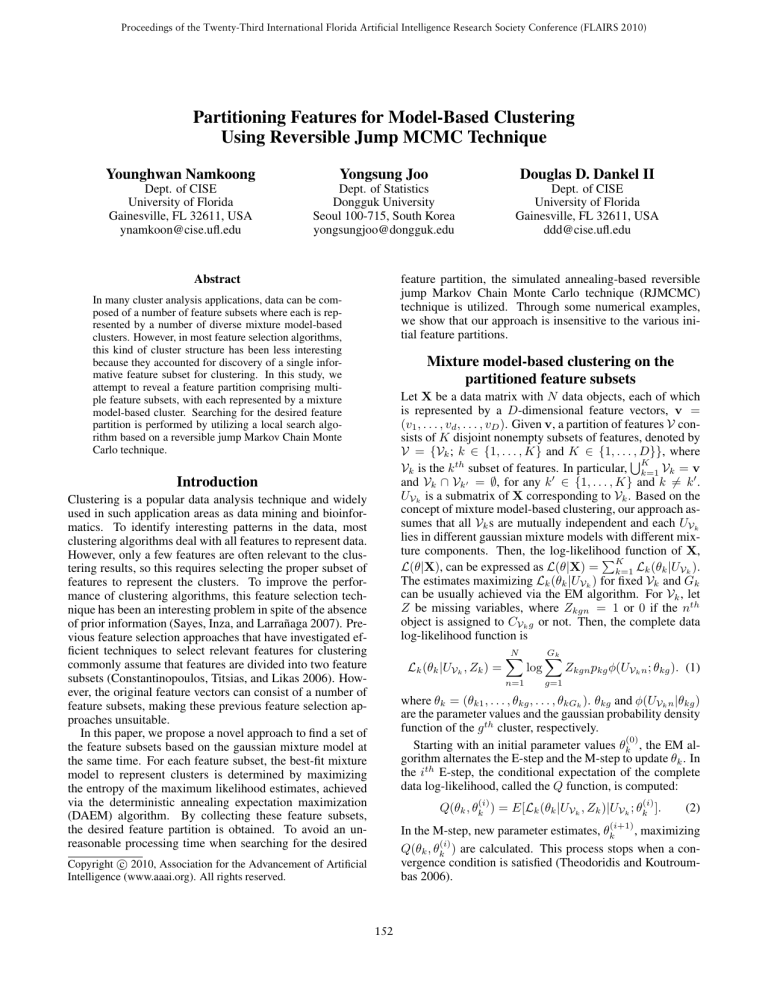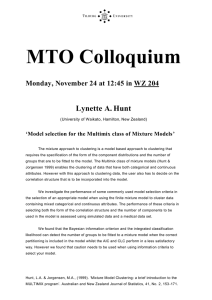
Proceedings of the Twenty-Third International Florida Artificial Intelligence Research Society Conference (FLAIRS 2010)
Partitioning Features for Model-Based Clustering
Using Reversible Jump MCMC Technique
Younghwan Namkoong
Yongsung Joo
Douglas D. Dankel II
Dept. of CISE
University of Florida
Gainesville, FL 32611, USA
ynamkoon@cise.ufl.edu
Dept. of Statistics
Dongguk University
Seoul 100-715, South Korea
yongsungjoo@dongguk.edu
Dept. of CISE
University of Florida
Gainesville, FL 32611, USA
ddd@cise.ufl.edu
feature partition, the simulated annealing-based reversible
jump Markov Chain Monte Carlo technique (RJMCMC)
technique is utilized. Through some numerical examples,
we show that our approach is insensitive to the various initial feature partitions.
Abstract
In many cluster analysis applications, data can be composed of a number of feature subsets where each is represented by a number of diverse mixture model-based
clusters. However, in most feature selection algorithms,
this kind of cluster structure has been less interesting
because they accounted for discovery of a single informative feature subset for clustering. In this study, we
attempt to reveal a feature partition comprising multiple feature subsets, with each represented by a mixture
model-based cluster. Searching for the desired feature
partition is performed by utilizing a local search algorithm based on a reversible jump Markov Chain Monte
Carlo technique.
Mixture model-based clustering on the
partitioned feature subsets
Let X be a data matrix with N data objects, each of which
is represented by a D-dimensional feature vectors, v =
(v1 , . . . , vd , . . . , vD ). Given v, a partition of features V consists of K disjoint nonempty subsets of features, denoted by
V = {Vk ; k ∈ {1, . . . , K} and K ∈ {1, . . . , D}}, where
K
Vk is the k th subset of features. In particular, k=1 Vk = v
and Vk ∩ Vk = ∅, for any k ∈ {1, . . . , K} and k = k .
UVk is a submatrix of X corresponding to Vk . Based on the
concept of mixture model-based clustering, our approach assumes that all Vk s are mutually independent and each UVk
lies in different gaussian mixture models with different mixture components. Then, the log-likelihood function of X,
K
L(θ|X), can be expressed as L(θ|X) = k=1 Lk (θk |UVk ).
The estimates maximizing Lk (θk |UVk ) for fixed Vk and Gk
can be usually achieved via the EM algorithm. For Vk , let
Z be missing variables, where Zkgn = 1 or 0 if the nth
object is assigned to CVk g or not. Then, the complete data
log-likelihood function is
Introduction
Clustering is a popular data analysis technique and widely
used in such application areas as data mining and bioinformatics. To identify interesting patterns in the data, most
clustering algorithms deal with all features to represent data.
However, only a few features are often relevant to the clustering results, so this requires selecting the proper subset of
features to represent the clusters. To improve the performance of clustering algorithms, this feature selection technique has been an interesting problem in spite of the absence
of prior information (Sayes, Inza, and Larrañaga 2007). Previous feature selection approaches that have investigated efficient techniques to select relevant features for clustering
commonly assume that features are divided into two feature
subsets (Constantinopoulos, Titsias, and Likas 2006). However, the original feature vectors can consist of a number of
feature subsets, making these previous feature selection approaches unsuitable.
In this paper, we propose a novel approach to find a set of
the feature subsets based on the gaussian mixture model at
the same time. For each feature subset, the best-fit mixture
model to represent clusters is determined by maximizing
the entropy of the maximum likelihood estimates, achieved
via the deterministic annealing expectation maximization
(DAEM) algorithm. By collecting these feature subsets,
the desired feature partition is obtained. To avoid an unreasonable processing time when searching for the desired
Lk (θk |UVk , Zk ) =
N
n=1
log
Gk
Zkgn pkg φ(UVk n ; θkg ). (1)
g=1
where θk = (θk1 , . . . , θkg , . . . , θkGk ). θkg and φ(UVk n |θkg )
are the parameter values and the gaussian probability density
function of the g th cluster, respectively.
(0)
Starting with an initial parameter values θk , the EM algorithm alternates the E-step and the M-step to update θk . In
the ith E-step, the conditional expectation of the complete
data log-likelihood, called the Q function, is computed:
(i)
(i)
Q(θk , θk ) = E[Lk (θk |UVk , Zk )|UVk ; θk ].
(i+1)
(2)
, maximizing
In the M-step, new parameter estimates, θk
(i)
Q(θk , θk ) are calculated. This process stops when a convergence condition is satisfied (Theodoridis and Koutroumbas 2006).
c 2010, Association for the Advancement of Artificial
Copyright Intelligence (www.aaai.org). All rights reserved.
152
state, a candidate feature partition V (t) is accepted by the
following probability γ :
π(V (t) )
(t)
(5)
exp{T } ,
γ = min 1, α =
π(V (t) )
To mitigate the local maxima problem of the EM algorithm due to the monotonic convergence property, one can
consider utilizing the deterministic annealing EM (DAEM)
algorithm that uses a modified log-likelihood including the
“thermodynamic free energy” parameter β (0 < β < 1)
(Theodoridis and Koutroumbas 2006). Specifically, the
DAEM algorithm starts with a small initial β, which is close
to 0. Then, until β becomes 1, the DAEM algorithm performs the E and M steps by gradually increasing β to obtain
a better local (and possibly global) maximum.
The estimated model can vary depending on the values of
the parameters, so an appropriate model amongst many candidate models should be selected. One natural way for this
problem is to choose a model which is the most similar to the
“true” model. For measuring the similarity between the true
model and the estimated model, it is a good choice to utilize the Akaike Information Criterion (AIC), a well-known
model selection method based on estimating the KullbackLeibler (KL) divergence. In the model selection process, an
estimated model is regarded as the best fitted model when
the score of AIC is minimized. For the given Vk , AIC(Vk )
is denoted by
AIC(Vk ) = −2 × Lk (θ̂k |Uk ) + 2λk ,
where T (t) = ρ × T (t−1) , t ≥ 1, and ρ is a cooling rate,
ρ ∈ (0, 1). π(V) be a probability mass function related with
V.
Simulation and Discussion
Three synthetic datasets for experiments were generated on
the basis of the following parameters: K, Gk s, V, pkg s,
μgd s, and Σgd s where g ∈ {1, . . . , Gk }, d ∈ {1, . . . , D},
and k ∈ {1, . . . , K}. For V, Vk is composed of a different
number of CVk g and its corresponding pkg . Each Xn lies in
a gaussian distribution corresponding to μkg and Σkg . For
example, the 1st dataset contains three feature subsets: V1 ,
V2 , and V3 . Each Vk has 3, 2, and 1 mixture components,
respectively. The other datasets have different shapes and
more complex structures than the 1st dataset. In particular,
the 2nd dataset has a checkerboard structure.
To cover the overall cases for each dataset, we used 5 different initial partition V (0) s. Specifically, each Vk in 1) is a
singleton feature subset, V (0) of 2) is a feature subset with
all features, and the remaining three V (0) s were randomly
generated. To support enough randomness, T (0) = 400.0
and ρ = 0.997. For the DAEM algorithm, the β (0) = 4.0
and β (i) = β (i−1) × 0.998. Through the simulation results,
our search method demonstrated insensitivity to the various
initial feature partitions by showing successful convergence
to the minimum score of the objective function and the parameter estimates near the true parameter values.
Our method can be useful in various application areas.
For example, in Bioinformatics, gene expression data consisting of genes (column) and experimental conditions (row)
can be expressed by multiple gene groups where each corresponds to a number of different condition clusters across the
above diverse gene subsets. Relevant experiments in various
application areas are currently in progress.
(3)
where Lk (θ̂k |Uk ) is the maximum log-likelihood, and λk is
the number of parameters θ̂k . By aggregating AIC(Vk )s,
feature partition consisting of multiple feature blocks where
each can be expressed by the best-fit mixture model for clustering can be obtained. Accordingly, the AIC for V, used for
an objective function in our approach, can be expressed by:
J(X, V, θ) =
K
AIC(Vk ).
(4)
k=1
Searching for the feature partition minimizing the objective function (4) through exhaustive search is quite challenging because the number of all possible partitions for a fixed
number of features grows hyper-exponentially. Moreover,
for each feature subset Vk in a given feature partition V, the
model selection process as well as the mixture model-based
clustering via the DAEM algorithm aggravate the prohibitive
computational complexity.
For such a combinatorial optimization problem, we attempt to search the desired feature partition V ∗ by using a
local search algorithm, called the biased random walk algorithm (Booth, Casella, and Hobert 2008). However, this
algorithm has several drawbacks such as the relative narrow
search region at each state and/or a local maxima problem.
This problem can be overcome by embedding another annealing process, called the Simulated Annealing (SA) technique, with the biased random walk algorithm. In SA, the
temperature parameter T (T > 0) represents the degree of
random transition between states, meaning that a candidate
state tends to be accepted at a high temperature. Our search
algorithm starts with the initial feature partition V (0) and the
initial temperature parameter T (0) set to a high value. Until
the final state becomes stable, when T → 0, this search algorithm explores V ∗ by gradually decreasing T . At the tth
References
Booth, J. G.; Casella, G.; and Hobert, J. P. 2008. Clustering
using objective functions and stochastic search. Journal Of
The Royal Statistical Society Series B 70(1):119–139.
Constantinopoulos, C.; Titsias, M. K.; and Likas, A. 2006.
Bayesian feature and model selection for gaussian mixture models. IEEE Trans. Pattern Anal. Mach. Intell.
28(6):1013–1018.
Sayes, Y.; Inza, I.; and Larrañaga, P. 2007. A review of
feature selection techniques in bioinformatics. BIOINFORMATICS 23(9):2507–2517.
Theodoridis, S., and Koutroumbas, K. 2006. Pattern Recognition, Third Edition. Orlando, FL, USA: Academic Press,
Inc.
153








